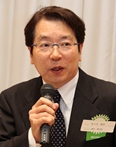��Smart City Project --- Providing Total Solution through Business Alliances ---��
March 21, 2012
Mr. Keishin Sasaki
President & CEO, e-solutions, inc.
 My speech today will be on how we can optimize the superior Japanese technology, through business alliances.
My speech today will be on how we can optimize the superior Japanese technology, through business alliances.
��About e-solutions
E-solutions seeks to solve national problems and design a social system by producing new projects, based on three criteria: 1) target the socially important themes including environment, security and health, 2) utilize the business framework to promote and expand the projects, and 3) formulate ��future design�� for projects and social system.
We produce our projects in an ��orchestra�� style, through collaboration with multiple strategic partners with unique strengths. Project designing is like composing music, while project management is like conducting a symphony.
��Team Minus 6%
I formulated the basic strategy for the ��Team Minus 6%�� in reducing CO2 emission. The Team was established in 2005, with about 200 companies, and grew into an epoch-making national campaign against global warming with as many as 35,000 corporate members by 2009.
The Ministry of the Environment intended to have an ambitious action plan but we preferred a targeted approach with six actions for CO2 reduction. For the first year, we focused exclusively on one initiative of ��temperature regulation.�� The smart city initiative can learn from the importance of careful screening of its theme.
��Aging Society
One-third of the Japanese population is projected to become 65 years or older by 2030. We have started analyzing various issues related to aging society, in collaboration with concerned ministries and agencies, institutions, organizations, business partners and citizens. We are reviewing the current social systems, including employment, to facilitate the creation of businesses and to motivate the working generation.
��Stem Cell Therapy for Stroke Patients
There are 300,000 new stroke patients every year in Japan, 40% of whom become bedridden and 33% suffer from aftereffects. We are conducting clinical research for the new medication therapy that makes use of the stem cells contained in the human bone marrow. Research results have shown the effectiveness and safety of this therapy, and we are currently working to start clinical trials also in the US.
��Smart City
Future Design Center (FDC) was established in the Kashiwa-no-ha Campus at Kashiwa City, Chiba. It aims to address various current and future national issues. I was appointed Director of the Center and my goal is to harness the intellectual and technological expertise of Japan and other countries and make the results of our ��advanced model�� available internationally.
����Japanese Competitiveness�� and ��Global Strategy to Win��
The Smart City-related market is forecast to total 3,100 – 4,000 trillion yen in the coming 20 years. Japan accounts for 70% of the patents for solar cells or electric cars, the technologies related to Smart City.
It is regrettable that Japan fails to optimize its superior technology. Market share for precision equipments have declined over 15 years, as seen in the mobile phone, DRAM, liquid crystal panel, DVD player or car navigation equipment markets.
I am concerned that our superior environmental and energy sectors might follow the same path of decline.
��Six Elements of Smart City
Smart City Project (SCP) includes the following six elements: 1) regional EMS, 2) smart building, 3) smart house, 4) distributed power source system, 5) infrastructure for next-generation vehicles, and 6) simulation. We formulate solutions, taking due account of local needs and restrictions, and try to address various challenges for the development of SCP.
��Various Challenges for the Development of Smart City:
• Challenge 1: Failure in comprehending the needs and restrictions
The global implementation of Smart City requires a comprehensive approach in pursuing its 25 functions. However, demonstrative tests in Hachinohe City (smart grid project) or Ohta City (coordinated solar power system) illustrate that only one part of the function is addressed with insufficient horizontal links. Tests on next-generation energy and social system conducted in
Yokohama City, Toyota City, Keihanna and Kitakyushu must take also a concerted approach in addressing various functions.
• Challenge 2: Malfunctioning business alliances
Business alliances in the form of consortiums have limitations, as companies tend to guard their intellectual properties. Companies may also agree with the plan in general, but do not compromise on details and dodge responsibility by shifting the blame to others.
• Challenge 3: Inefficient marketing
There is now abundant information on smart cities. Companies are therefore urged to prepare a uniformed message, synchronize and disseminate it.
• Challenge 4: Insufficient standardization
The current demonstrative tests are conducted through different technologies and business methods. Such approach will trigger price competition among Japanese companies, while allowing foreign companies to acquire our technological expertise in just a few years.
• Challenge 5: Vertically-segmented ordering system
Vertically-segmented ordering from each section/division of the municipality to individual company will result in incoherent development of technology and partial city planning.
• Challenge 6: Insufficient scheme for financial assistance
We must take immediate actions to catch up with countries around the world where their urban development is based on the actual smart city framework.
We will provide the following solutions to the aforementioned challenges: 1) framework for social systematization, 2) optimal solution through corporate alliances 3) joint marketing, 4) formulation of Japanese standard model, 5) formulation of one-stop-system, and 6) providing solutions with financial resources.
We feel privileged to receive business inquiries from around the world. I am determined to turn our technological competence and know-how, handed down from our seniors, into giving Japan a competitive advantage.